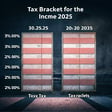
Tax season can be overwhelming, but it doesn't have to be. With 2025 approaching, several new and expanded tax credits could put more money in your pocket. Understanding these credits early gives you time to prepare and maximize your potential refund. Let's break down the eligibility requirements for these credits and see if you might qualify.
What's Changing in 2025 Tax Credits
The tax landscape continues to evolve, with several significant changes coming in 2025. Some credits are being expanded, while others are new additions designed to provide relief to specific groups of taxpayers.
Extended Clean Energy Tax Credits
The Inflation Reduction Act of 2022 established several energy-related tax credits that continue into 2025. The Residential Clean Energy Credit remains at 30% for qualifying solar, wind, and geothermal installations. This credit applies to systems installed in your primary or secondary residence and has no upper dollar limit.

"The extension of these credits represents a significant opportunity for homeowners to invest in sustainable energy while receiving substantial tax benefits," notes Janet Williams, a tax specialist at Green Tax Advisors.
For example, if you install a $20,000 solar panel system in 2025, you could receive a $6,000 tax credit. Unlike some other credits, this one carries forward if you can't use it all in one tax year.
Enhanced Child Tax Credit
While not finalized yet, proposed legislation would expand the Child Tax Credit in 2025. Currently, the credit is $2,000 per qualifying child under 17, with $1,600 refundable. The proposed changes would:
- Increase the maximum credit amount
- Expand refundability options
- Adjust income phase-out thresholds
To qualify, you must:
- Have a qualifying child under 17 at the end of the tax year
- Meet income requirements (currently phasing out at $200,000 for single filers and $400,000 for joint filers)
- Provide the child's Social Security Number on your tax return
The credit's final structure will depend on congressional action, so stay tuned for updates as we approach 2025.
Am I Eligible for the New Home Energy Credits?
The Energy Efficient Home Improvement Credit (formerly known as the Nonbusiness Energy Property Credit) continues in 2025 with generous benefits. This credit applies to energy-efficient improvements to your primary residence.
Eligible improvements include:
- Energy-efficient windows and doors (up to $600 per item)
- Heat pumps and heat pump water heaters (up to $2,000)
- Biomass stoves and boilers (up to $2,000)
- Home energy audits (up to $150)
The annual limit for this credit is $1,200 for most improvements, with exceptions for heat pumps and biomass systems that can qualify for up to $2,000 additional credit.
I recently spoke with Tom Chen, who installed new energy-efficient windows last summer. "I wasn't planning to replace my windows until 2026, but when I learned about these credits, I moved up my timeline. The tax savings made the project much more affordable," he said.
To qualify, you must:
- Own the home where improvements are installed
- Use it as your primary residence
- Purchase qualifying products that meet specific energy efficiency requirements
- Have installation completed during the 2025 tax year
- Keep receipts and manufacturer certifications
Electric Vehicle Tax Credits: New Rules for 2025
The Clean Vehicle Credit remains available in 2025, offering up to $7,500 for new electric vehicles and up to $4,000 for used ones. However, eligibility requirements are getting stricter.
For new vehicles, requirements include:
- Final assembly in North America
- Battery components increasingly sourced from North America or free trade partners
- Critical minerals sourced from the US or free trade partners
- MSRP caps ($80,000 for vans, SUVs, and trucks; $55,000 for other vehicles)
- Income limits ($300,000 for married filing jointly, $225,000 for head of household, $150,000 for others)
Used electric vehicles must:
- Be at least two model years old
- Cost $25,000 or less
- Be purchased from a dealer
- Not have been previously transferred after August 16, 2022
"The manufacturing requirements get stricter each year," explains automotive analyst Maria Rodriguez. "In 2025, more battery components must come from North America than in previous years. This means some vehicles that qualified in 2024 might not qualify in 2025."
Work Opportunity Tax Credit Expansion
While primarily a business tax credit, the Work Opportunity Tax Credit (WOTC) is worth understanding if you're an employer or looking to start a business in 2025. This credit incentivizes hiring individuals from certain target groups who face employment barriers.
The credit ranges from $2,400 to $9,600 per eligible employee, depending on:
- Hours worked
- Wages paid
- Which target group the employee belongs to
Target groups include:
- Veterans
- SNAP (food stamp) recipients
- Ex-felons
- Long-term unemployment recipients
- Residents of designated community zones
Small business owner Jamal Washington told me, "The WOTC helped me expand my team while supporting my community. Last year, I hired three eligible workers and received over $7,000 in tax credits."
How Do Income Limits Affect My Eligibility?
Many tax credits phase out as your income increases. Understanding these thresholds helps you plan effectively.
| Tax Credit | Single Filer Phase-out Begins | Joint Filer Phase-out Begins |
|---|---|---|
| Child Tax Credit | $200,000 | $400,000 |
| Clean Vehicle Credit | $150,000 | $300,000 |
| Earned Income Credit | Varies by filing status | Varies by filing status |
| Premium Tax Credit | 400% of federal poverty line | 400% of federal poverty line |
If your income is near these thresholds, consider tax planning strategies like:
- Maximizing retirement contributions
- Timing income and deductions strategically
- Exploring business expense opportunities if self-employed
- Considering charitable giving
What About Retirement Savings Credits?
The Retirement Savings Contributions Credit (Saver's Credit) helps low and moderate-income taxpayers save for retirement while reducing their tax bill. For 2025, proposed changes would make this credit more generous and accessible.
Currently, the credit is worth up to 50% of your retirement contributions, with a maximum credit of $1,000 ($2,000 if married filing jointly). Eligibility is based on income and filing status.
The proposed changes would:
- Increase the maximum credit percentage
- Raise income thresholds to include more middle-income taxpayers
- Make the credit fully refundable (currently it's nonrefundable)
To qualify, you must:
- Be 18 or older
- Not be a full-time student
- Not be claimed as a dependent on someone else's return
- Meet income requirements
- Contribute to a qualified retirement plan (401(k), IRA, etc.)
Common Questions About 2025 Tax Credits
Will the Expanded Child Tax Credit Be Fully Refundable?
While proposals exist to make the Child Tax Credit fully refundable in 2025, this hasn't been finalized. Currently, only $1,600 of the $2,000 credit is refundable (meaning you can receive it even if you don't owe taxes). Congressional action in the coming months will determine the final structure.
How Do I Claim These Credits on My 2025 Tax Return?
To claim these credits, you'll need to:
- File the appropriate tax forms (typically Form 1040 plus specific schedules)
- Provide supporting documentation (receipts, certifications, etc.)
- Keep records of qualifying expenses or situations
- Consider consulting a tax professional for complex situations
The IRS typically releases updated forms and instructions in late 2025 for the upcoming tax season.
Can I Get These Credits If I'm Self-Employed?
Yes! Self-employed individuals can claim most of these credits. In fact, some credits like the home energy improvements credit apply regardless of employment type. For business-related credits like the WOTC, self-employed individuals with employees can also benefit.
Planning Ahead for 2025 Tax Credits
Taking advantage of these credits requires planning. Here are steps to consider:
- Assess your potential eligibility based on current and projected income
- Document qualifying expenses throughout the year
- Keep manufacturer certifications for energy-efficient products
- Consider timing major purchases to maximize available credits
- Consult with a tax professional for personalized guidance
Remember that tax laws can change, and final regulations for 2025 may differ from current proposals. Staying informed through reputable sources like the IRS website or consulting with a tax professional can help you navigate these changes.
Disclaimer
This article is for informational purposes only and does not constitute tax, legal, or financial advice. Tax laws are complex and subject to change. Eligibility requirements, credit amounts, and other details may change before or during the 2025 tax year. Always consult with a qualified tax professional regarding your specific situation.
Tags

About Evan L. Chamberlain the Author
Evan L. Chamberlain is a seasoned personal-finance strategist with over 15 years of experience in helping individuals maximize their savings and efficiently manage debt. His approachable insights on budgeting and investment have empowered thousands to take control of their financial futures.
Recommended Articles
These States Are Cutting Property Taxes for Seniors in 2025
Discover which states are cutting property taxes for seniors in 2025, providing essential financial relief for those on fixed incomes.
These States Are Cutting Property Taxes for Seniors in 2025
Discover which states are cutting property taxes for seniors in 2025, helping them manage financial stability with important relief programs.
Freelancer Tax Tips: Deductions You Might Be Missing
Freelancers often overlook key tax deductions that can reduce their 15.3% self-employment tax burden, such as the home office deduction, self-employed health insurance, and retirement plan contributions. It's crucial to keep accurate records and consult with a tax professional to ensure compliance while benefiting from deductions on business travel, professional development, and other legitimate business expenses.
How to Legally Reduce Your Tax Bill in 2025
To legally reduce your tax bill in 2025, consider strategies such as maximizing retirement account contributions, using health savings accounts, strategically itemizing deductions versus taking the standard deduction, leveraging business expense deductions for the self-employed, employing tax-loss harvesting for investments, and taking advantage of real estate tax benefits. Be proactive in your tax planning, particularly in light of impending changes to the Tax Cuts and Jobs Act set to expire after 2025, and consult with a tax professional for personalized advice.
Understanding Tax Brackets: What You Really Pay in 2025
In 2025, taxpayers should understand that the U.S. operates on a progressive tax system where only income exceeding a certain bracket's threshold is taxed at that higher rate, not the entire income, and effective tax rates are generally lower than the marginal tax rates. Utilizing tax credits, standard deductions, and retirement contributions can optimize tax positions, and adjustments for inflation have slightly increased 2025 tax brackets by 3.1% to prevent bracket creep, with major tax law changes possible after the Tax Cuts and Jobs Act's sunset in 2025.




